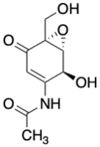Chemistry:Cetoniacytone A

| |
| Names | |
|---|---|
| IUPAC name
N-[(1R,2S,6R)-2-hydroxy-6-(hydroxymethyl)-5-oxo-7-oxabicyclo[4.1.0]hept-3-en-3-yl]acetamide
| |
| Identifiers | |
3D model (JSmol)
|
|
| ChEBI | |
| ChemSpider | |
| KEGG | |
PubChem CID
|
|
| |
| |
| Properties | |
| C9H11NO5 | |
| Molar mass | 213.189 g·mol−1 |
Except where otherwise noted, data are given for materials in their standard state (at 25 °C [77 °F], 100 kPa). | |
| Infobox references | |
Cetoniacytone A is a secondary metabolite classified in the family of C7N aminocyclitols which include other natural products such as validamycin A, acarbose, and epoxyquinomicin.[1] Cetoniacytone A was first identified from a culture of Actinomyces sp. (strain Lu 9419), an endosymbiotic Gram-positive bacillus found in the intestines of a rose chafer (Cetonia aureata).[2] Preliminary feeding studies with [U-13C3]glycerol identified the core moiety, cetoniacytone, to be derived via the pentose phosphate pathway. Although agar plate diffusion assay studies of cetoniacytone A showed no antimicrobial activity against Gram-positive and Gram-negative bacteria, cetoniacytone A has demonstrated a significant growth inhibitory effect against human cancer cell lines including hepatocellular carcinoma (HEP G2) and breast adenocarcinoma (MCF 7).[2][3]
Biosynthesis
Feeding experiments conducted by Zeeck and co-workers established the synthesis of Cetoniacytone A to proceed via the pentose phosphate pathway with sedoheptulose-7- phosphate as the key intermediate.[2] Sedoheptulose-7- phosphate first undergoes a cyclization catalyzed by 2-epi-5-epi-valiolone synthase (CetA) yielding 2-epi-5-epi-valiolone. Following the cyclization, 2-epi-5-epi-valiolone epimerase (CetB) results in an inversion of the stereochemistry of the alcohol alpha to the ketone forming 5-epi-valiolone. Next, CetL, a type of oxidoreductase, results in the oxidation of the C-4 hydroxyl group to give 2-keto-5-epi-valiolone followed by a transamination catalyzed by aminotransferases CetM to give 2-amino-5-epi-valiolone. The sequential reactions depicted in the dashed box represent putative pathways that involve oxidoreductase, dehydrogenase, and hypothetical proteins related to the cupin superfamily to yield cetoniacytone B. Lastly, cetoniacytone B is acetylated via an arylamine N-acetyltransferase (CetD) to yield cetoniacytone A.[3]

References
- ↑ Mahmud, Taifo (2003). "The C7N aminocyclitol family of natural products.". Natural Product Reports 20 (2): 137–166. doi:10.1039/B205561A. PMID 12636088.
- ↑ 2.0 2.1 2.2 2.3 Schlorke O, Krastel P, Muller I, Uson I, Dettner K, and Zeeck A (2002). "Structure and Biosynthesis of Cetoniacytone A, a Cytotoxic Aminocarba Sugar Produced by an Endosymbiontic Actinomyces.". Journal of Antibiotics 55 (7): 635–642. doi:10.7164/antibiotics.55.635. PMID 12243453.
- ↑ 3.0 3.1 Wu X, Flatt M, Xu H, and Mahmud T (2009). "Biosynthetic Gene Cluster of Cetoniacytone A, an Unusual Aminocyclitol from the Endosymbiotic Bacterium Actinomyces sp. Lu 9419.". ChemBioChem 10 (2): 304–314. doi:10.1002/cbic.200800527. PMID 19101977.
 |

